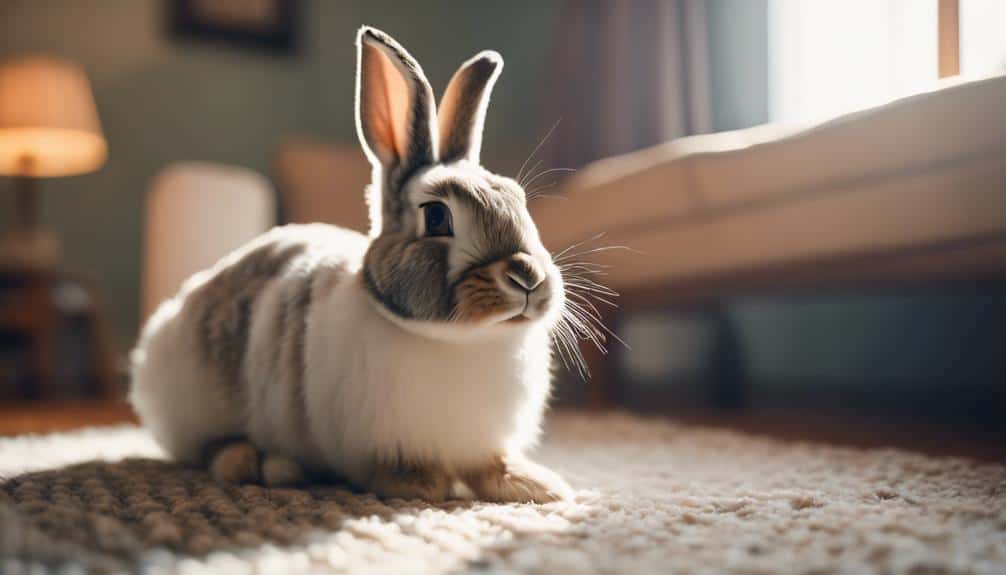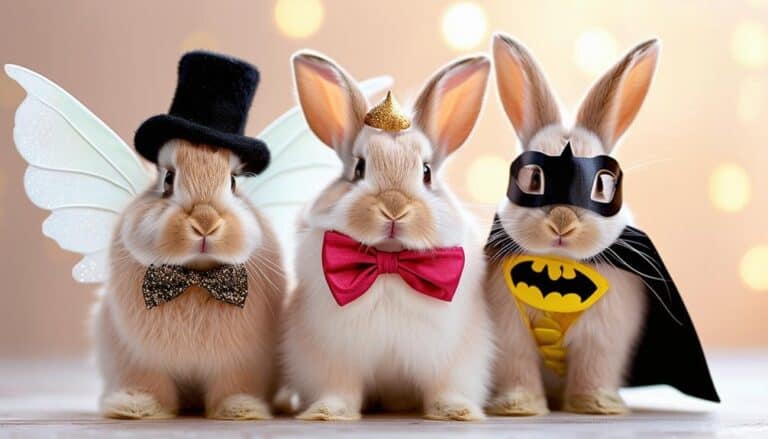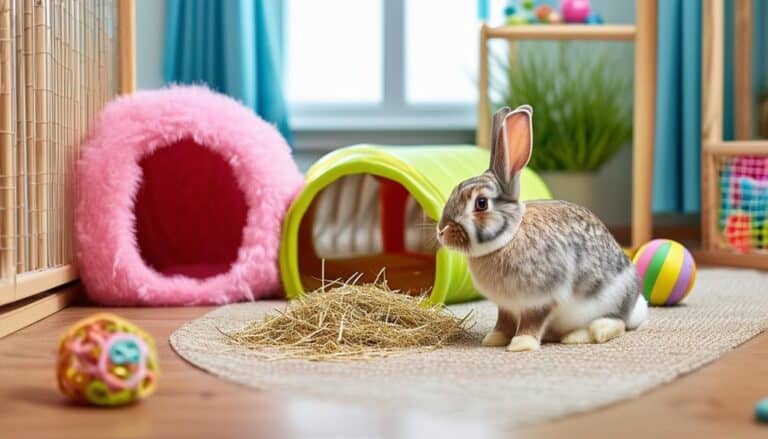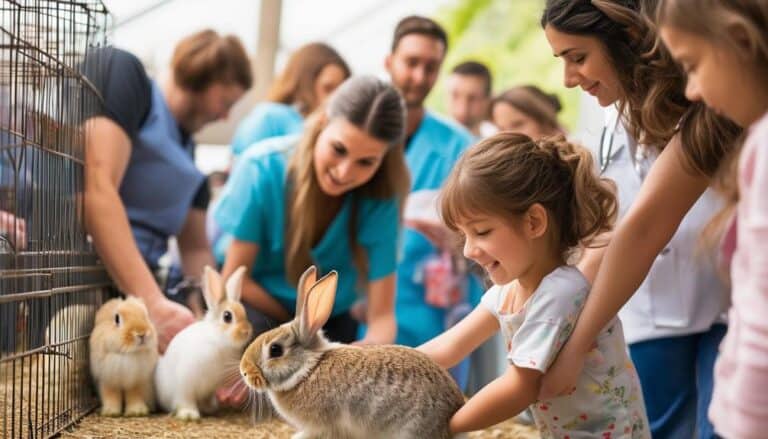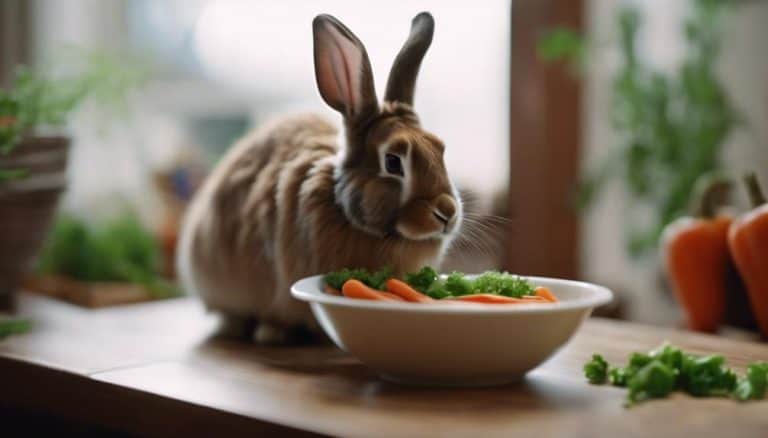Defining Typical Pet Rabbit Temperament
When you think of pet rabbits, you might picture a cuddly, friendly companion, but did you know their temperaments can vary widely? Some rabbits are outgoing and thrive on human interaction, while others are more reserved and cautious.
Understanding these personality differences can help you build a stronger bond with your rabbit. By observing their behavior and responses to different stimuli, you can gain valuable insights into their unique temperament.
But what factors contribute to these variations, and how can you best meet your rabbit’s individual needs? Let’s explore this fascinating topic further.
Understanding Rabbit Personalities
Understanding your rabbit’s unique personality is vital for providing appropriate care and fostering a strong bond. Rabbit personalities can vary widely, from the sweet and affectionate to the shy and aloof, with each bunny exhibiting distinct traits. Recognizing whether you have a shy rabbit or a more outgoing one allows you to tailor your interactions and care strategies accordingly.
In observing rabbit personalities, you’ll notice some bunnies are introverted, preferring solitude and quiet corners, while others are extroverted, seeking attention and interaction. Identifying these tendencies helps in creating an environment that caters to your rabbit’s preferences, ensuring they feel secure and content.
For instance, a shy rabbit may benefit from a gradual introduction to new spaces and people, reducing stress and fostering trust. Additionally, understanding the roots of any aggressive behavior is essential. Often, such behavior stems from fear or territorial instincts. Employing techniques like slow desensitization and positive reinforcement can mitigate these issues, promoting a more harmonious relationship.
Personality Traits by Age
Rabbit personalities evolve distinctly at each life stage, influencing their behavior, activity levels, and interactions with humans and other pets. Understanding these stages can help you provide appropriate care and training.
Young rabbits are typically more energetic and curious, displaying exploratory rabbit behavior that includes hopping around and investigating their environment. They’re generally trusting and open to social interactions, making this an ideal time for initial bonding and training.
As rabbits enter adolescence, you’ll notice a shift. Adolescent rabbits often test boundaries and may exhibit nesting behaviors or signs of hormonal changes. This period can be marked by increased territoriality and sometimes aggression, necessitating patience and consistent training.
Upon reaching adulthood, rabbits usually settle into a more balanced state. Adult rabbit behavior is characterized by a mix of activity and relaxation, making them more predictable and easier to manage. They form strong bonds with their human companions and can be very affectionate.
Senior rabbits tend to mellow, showing reduced energy levels and a preference for routine. Their interactions may become more subdued, requiring gentle handling and tailored care to accommodate their aging needs.
Environmental Influences
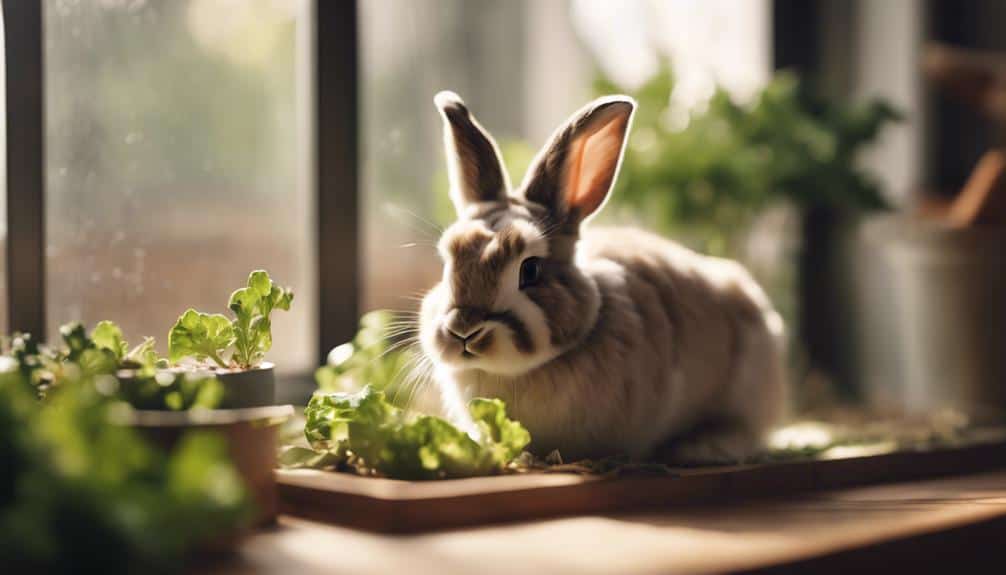
When considering a pet rabbit’s temperament, you’ll find that environmental factors play a pivotal role. Living space impacts their stress levels and overall well-being, while social interactions greatly shape their behavior.
Additionally, environmental enrichment benefits include reducing boredom and promoting a balanced temperament.
Living Space Impact
A rabbit’s temperament and behavior are greatly influenced by its living space, with environmental enrichment, adequate space, and hiding spots playing essential roles. When you provide a rabbit with a well-structured living space, you’re contributing positively to its overall well-being.
A spacious environment allows for natural behaviors such as hopping and exploring, reducing stress levels and promoting a calm demeanor.
Environmental enrichment should be a priority in your rabbit’s habitat. This includes offering a variety of toys, tunnels, and chewable items. These elements stimulate mental engagement, preventing boredom and related behavioral issues like aggression or excessive chewing.
Adequate space isn’t just about physical room but also about the quality of that space. Incorporating hiding spots, like small shelters or tunnels, gives your rabbit a sense of security and lowers anxiety.
Conversely, a lack of space or enrichment can lead to stress, which manifests in destructive behaviors and a timid or aggressive temperament. By ensuring a stimulating and spacious environment, you’re more likely to have a happy, well-adjusted rabbit that exhibits a friendly and curious personality.
Prioritizing these factors creates a harmonious living space, aligning with your desire for freedom in pet care.
Social Interaction Effects
Consistently positive social interactions greatly influence a rabbit’s temperament, promoting sociability and reducing the likelihood of fear or aggression. When you engage regularly with your rabbit, you’re fostering a trusting relationship that encourages a more outgoing and friendly demeanor. This is important because rabbits are naturally social creatures that thrive on interaction, both with humans and other animals.
Conversely, negative experiences or insufficient socialization can result in a shy and fearful rabbit. If a rabbit lacks regular, positive social interaction, it may develop defensive behaviors, including aggression. Hence, ensuring that your rabbit’s social environment is consistently positive is essential. This means not only spending time with your rabbit but also providing opportunities for it to safely interact with other pets.
Environmental factors are paramount in shaping a rabbit’s social behavior. A nurturing and stimulating environment that includes ample social interaction can greatly improve your rabbit’s temperament. By avoiding negative experiences and promoting a safe, interactive habitat, you can mitigate the development of shyness and fear.
Essentially, the quality and consistency of social interaction your rabbit experiences directly influence its overall temperament and sociability.
Environmental Enrichment Benefits
Understanding the importance of social interaction, it’s also important to recognize how environmental enrichment benefits your rabbit by providing mental stimulation, physical activity, and reducing stress. For a house rabbit, a stimulating environment can prevent boredom-related behaviors like excessive chewing or digging. By incorporating elements like toys, tunnels, and hiding spots, you mimic a rabbit’s natural habitat, encouraging exploration and activity.
Providing an enriched environment promotes overall well-being and can greatly enhance your rabbit’s quality of life. These activities offer necessary mental stimulation, keeping your rabbit engaged and curious. Physical activity derived from exploring and playing is essential for maintaining excellent health, preventing obesity, and promoting cardiovascular fitness.
Moreover, a well-enriched environment reduces stress, which is essential for a rabbit’s temperament and behavior. Stress reduction can lead to a happier, healthier, and more active pet rabbit. Ensuring that your house rabbit has access to a variety of enrichment tools helps in the development of a well-rounded and content pet.
Meeting Your Rabbit
Meeting your rabbit in person is essential to accurately assess its temperament and personality traits. Observing your rabbit’s interactions with you and its environment provides invaluable data on its behavioral patterns. Initial meetings are critical for understanding how your rabbit responds to various stimuli, helping you gauge its temperament reliably.
When you first meet your rabbit, pay close attention to its body language and reactions. Does it approach you with curiosity, or does it exhibit signs of anxiety? These cues are crucial for understanding its baseline temperament.
Spend ample time with your rabbit to build trust and strengthen your bond, which in turn reveals more about its inherent personality traits.
Your rabbit’s responses to different situations—such as being handled, exposed to new environments, or introduced to other pets—offer further insight into its temperament. For instance, a rabbit that remains calm during these encounters likely has a more laid-back temperament, while one that exhibits stress may have a more nervous disposition.
Ultimately, the initial meeting sets the foundation for a deeper understanding of your rabbit’s temperament. This knowledge enables you to tailor your care practices, ensuring a harmonious and enriching life for your pet rabbit.
Hormonal Impact on Behavior
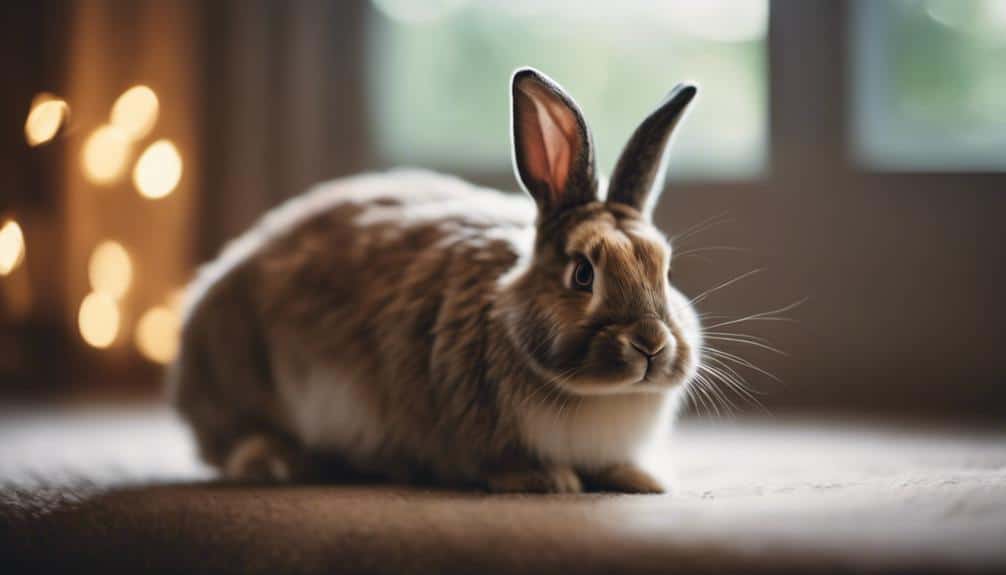
Hormonal fluctuations can greatly change your rabbit’s behavior, often leading to mood swings and territorial aggression. Unfixed rabbits are particularly prone to displaying hormonal-driven behaviors such as spraying, mounting, and increased aggression. These behaviors are attributable to hormonal imbalances, which can cause significant stress and even health issues for your pet.
Spaying or neutering your rabbit is a highly effective strategy for mitigating these hormonal influences. By removing the primary sources of sex hormones, these procedures can stabilize your rabbit’s mood and reduce aggressive tendencies. This not only makes your rabbit more manageable but also improves its overall well-being.
Another important aspect to take into account is that hormonal imbalances can alter your rabbit’s social interactions. Rabbits experiencing these imbalances may become more territorial, creating challenges if you have multiple pets. Understanding and addressing the impact of hormones is vital for fostering a harmonious environment for both you and your rabbit.
Ultimately, managing hormonal influences through spaying or neutering is essential for improving your rabbit’s temperament and quality of life. By taking these steps, you’re ensuring a more balanced, stress-free, and healthier environment for your furry friend.
Socialization and Bonding
When you socialize your rabbit from a young age, you can greatly influence their temperament and behavior. Building a strong bond involves trust, respecting boundaries, and interpreting their communication cues accurately.
Understanding rabbit group dynamics and fostering positive interactions can enhance their well-being and help them thrive in a domestic environment.
Early Interaction Benefits
Engaging in early interaction with your rabbit is essential for fostering trust and strengthening the bond, ensuring a well-adjusted and sociable pet. Early socialization plays a key role for rabbits, as it positively influences their comfort level with handling and unfamiliar experiences.
By regularly handling and engaging with your rabbit from a young age, you can facilitate bonding and socialization, resulting in a more affectionate and confident companion.
Young rabbits exposed to consistent, positive interactions are less likely to develop shyness or fearfulness. This early exposure helps them acclimate to various stimuli, reducing stress and anxiety in the long term.
Evidence suggests that rabbits who experience early socialization exhibit better adaptability and resilience, making them more open to new environments and situations.
Moreover, the process of early socialization involves gradual and gentle handling, allowing your rabbit to associate human contact with positive experiences. This practice not only strengthens your relationship but also promotes a sense of security and trust.
Consequently, well-socialized rabbits tend to display fewer behavioral issues and exhibit a more relaxed demeanor.
Bonding With Humans
Building a strong bond with your rabbit requires consistent socialization and positive interactions to establish trust and mutual understanding. To foster this connection, you must engage in activities that promote bonding with humans and build trust. Begin by spending quality time together, ensuring that interactions are positive and reinforcing.
Understanding your rabbit’s body language and preferences is essential. Pay attention to their reactions and adjust your behavior accordingly.
Here are some evidence-based techniques to enhance bonding and socialization:
- Petting and grooming: Regular, gentle grooming sessions can help your rabbit feel more comfortable and secure.
- Consistent care: Providing daily care and attention builds trust, showing your rabbit they can rely on you.
- Positive reinforcement: Use treats and praise to encourage desired behaviors, reinforcing the bond between you.
- Safe environment: Create a secure space where your rabbit feels relaxed and free to explore.
- Interactive play: Engage in play activities that stimulate your rabbit’s mind and body, fostering a deeper connection.
Rabbit Group Dynamics
Understanding rabbit group dynamics is essential for fostering healthy socialization and bonding among your pet rabbits. Rabbits, being inherently social animals, thrive in pairs or groups where they can form strong, enduring bonds. Proper socialization is vital for allowing them to exhibit natural behaviors, reduce stress levels, and enhance their overall well-being.
When it comes to bonding rabbits, the process requires careful introductions and diligent monitoring of their interactions. Initially, keep the rabbits in neutral territory to prevent territorial aggression. Gradually increase their time together while observing their behavior closely. Signs of positive bonding include mutual grooming, cuddling, and relaxed body language. Conversely, watch for any aggressive actions, such as biting or chasing, which may indicate the need for more gradual introductions.
Group dynamics among rabbits can vary significantly. Some rabbits will form close, affectionate friendships, while others may establish clear hierarchies within the group. Understanding these social behaviors helps you create a supportive and enriching environment. By acknowledging and facilitating these group dynamics, you can ensure your rabbits live harmoniously, thereby promoting their physical and emotional health.
Creating such an environment will allow your rabbits the freedom to thrive naturally.
Identifying Temperament Types
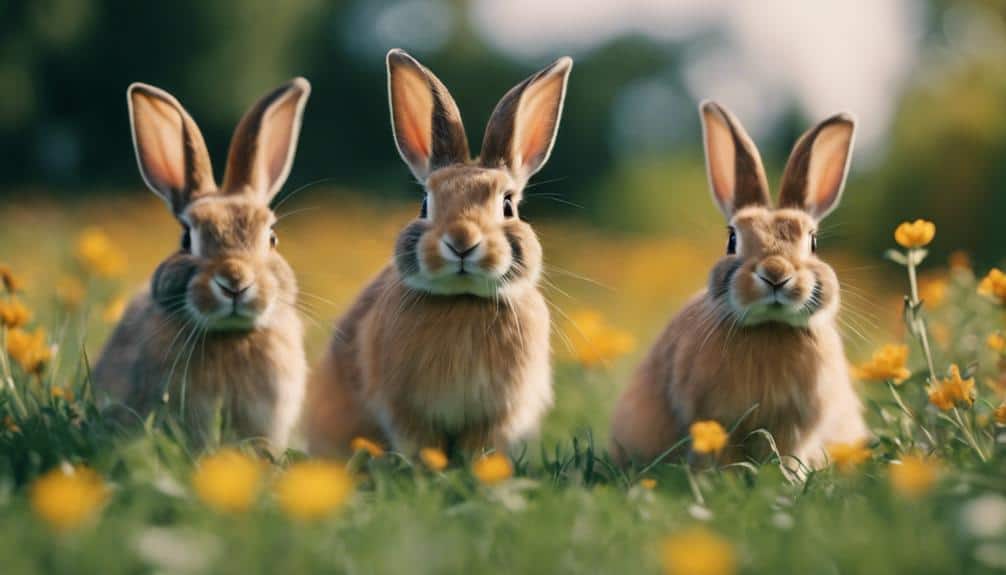
When identifying temperament types in pet rabbits, observing their behavior patterns and interactions with their environment becomes crucial. Understanding these nuances helps you provide appropriate care tailored to each rabbit’s needs.
Rabbits exhibit a range of temperament types, from friendly and social to shy and reserved. Recognizing these will guide you in creating a nurturing environment for your pet rabbit. Here are some key temperament traits to watch for:
- Friendly and Social: These rabbits seek constant attention and affection, often enjoying being petted and held.
- Shy and Reserved: These rabbits may be cautious and prefer solitude, needing time to build trust.
- Independent and Aloof: Such rabbits are content being on their own and may not seek out interaction frequently.
- Aggressive: This behavior, often rooted in fear or territorial instincts, can manifest through biting or lunging.
- Evolving Personalities: Rabbit temperaments can change with age, from trusting babies to settled adults and mellow seniors.
Conclusion
By understanding your rabbit’s unique temperament, you’ll foster a stronger bond and a more positive relationship. Consider their age, environmental factors, and hormonal influences when observing their behavior.
Pay attention to socialization cues and tailor your interactions accordingly. Identifying their personality traits accurately will help you meet their needs more effectively.
Ultimately, a well-understood rabbit is a happier, healthier pet, enhancing both your lives. So, take the time to truly know your rabbit.

